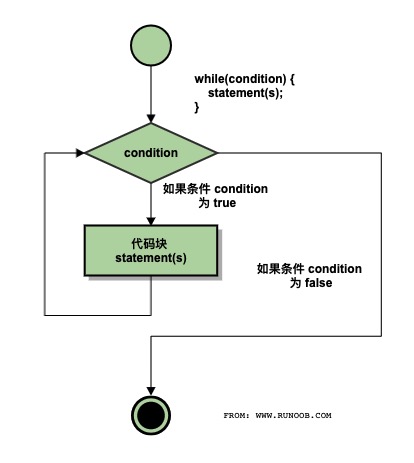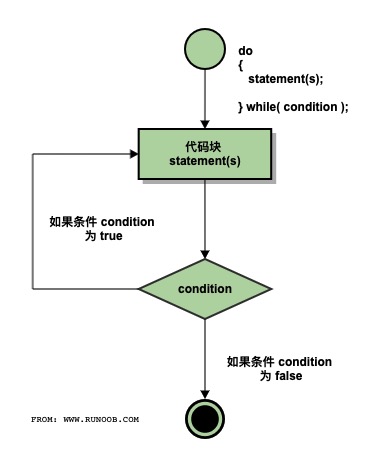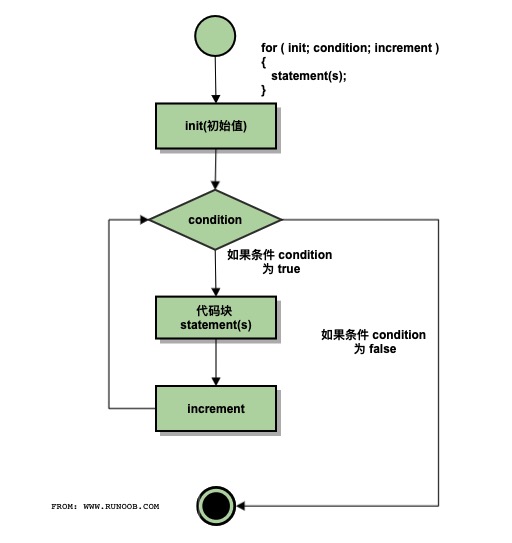流程控制语句
- 顺序语句
特点:语句逐句执行
- 选择语句
特点:出现了一种以上的情况时使用
- 循环语句
在某个条件成立的情况下,循环执行某个语句、
关键字:
- 选择:
if-else,which-case;- 循环:
while,do-while,for,if-goto;- 辅助控制:
continue,break,and so on.
1.if-else语句
语句格式:
if(表达式)
命令1;
[else
命令2;
]
注意:使用该种表达式时,else默认与最近的if语句匹配。
if(表达式)
{
命令1;
}
[else
{
命令2;
}]
Example:
#include <stdio.h>
#include <stdlib.h>
int main()
{
while(1)
{
float s;
printf("Enter the Scores:");
scanf("%f",&s);
//首先规定分数必须0~100
if(s < 0 || s > 100)
{
printf("请输入一个合理的分数!\n");
//fprintf(stderr,"Input Error!\n");
//break;
exit(1);
}
//判断scores属于哪个区间
if(s >= 90 && s <= 100)
{
printf("分数等级为A!\n");
//puts("A");字符专用输出语句
continue;
}
if(s >= 80 && s < 90)
{
printf("分数等级为B!\n");
continue;
}
if(s >= 70 && s < 80)
{
printf("分数等级为C!\n");
continue;
}
if(s >= 60 && s < 70)
{
printf("分数等级为D!\n");
continue;
}
else
{
printf("分数等级为E!\n");
continue;
}
}
exit(0);
}
输出结果:
tianxun@tianxun:~/Desktop/C-Language/progress$ ./if-else
Enter the Scores:-1
请输入一个合理的分数!
tianxun@tianxun:~/Desktop/C-Language/progress$ ./if-else
Enter the Scores:101
请输入一个合理的分数!
tianxun@tianxun:~/Desktop/C-Language/progress$ ./if-else
Enter the Scores:99
分数等级为A!
Enter the Scores:87
分数等级为B!
Enter the Scores:78
分数等级为C!
Enter the Scores:65
分数等级为D!
Enter the Scores:59
分数等级为E!
Enter the Scores:105
请输入一个合理的分数!
Example2:判断闰年与平年
变量:year;
输入:year;
判断条件:year 可以被4整除且不能被100整除或者可以被400整除。
#include <stdio.h>
#include <stdlib.h>
int main()
{
while(1)
{
int year;
printf("Please Input Year : ");
scanf("%d",&year);
if(year % 4 == 0 && year % 100 != 0 || year % 400 == 0)
{
printf("%d is leap year!\n",year);
}
else
{
printf("%d isn't leap year!\n",year);
exit(1);
}
}
exit(0);
}
输出结果:
xs@jxs-ubuntu:~/Desktop/c language/if-else$ ./year
Please Input Year : 2020
2020 is leap year!
Please Input Year : 2022
2022 isn't leap year!
2.switch-case语句
语句格式
switch(表达式)
{
//常量表达式:字符、字符串、常量等,不能是表达式
case 常量表达式:
[CMD];
break;
case 常量表达式:
[CMD];
break;
···
default: //当表达式均不满足上述常量表达式时,默认执行此命令
[CMD];
break;
}
Example:
#include <stdio.h>
#include <stdlib.h>
int main()
{
char ch;
ch = getchar();
switch(ch)
{
case 'A':
case 'a':
printf("Ahahahhahah\n");
default:
printf("Please Repeat Input Again!\n");
}
exit(0);
}
输出结果:
break表示退出当前switch语句,如果没有break,就会继续执行下一个case语句,出现程序执行达不到目的。
3.while ,do-while语句
语句格式
while:
while (表达式) //满足该表达式时,开始循环
{
循环体语句;
}
do-while:
do
{
循环体语句;
} while(表达式); //满足表达式时继续循环,不满足就只执行一次退出循环
while逻辑结构:

do-while逻辑结构:

两者的区别在于:
- while 中的循环体至少执行的次数为0次,原因在于进入循环之前要先判断条件是否满足,不满足不会执行!
- do-while中的循环体至少执行的次数为1次,原因在于终止条件在执行一次语句之后,因此是先执行循环体,在判断是否满足终止条件,无论什么情况下都要执行一次循环体。
4.for & if-goto循环语句
语句格式
//for由初始条件判断,因此至少执行0次
for(表达式1;表达式2;表达式3) //先执行表达式1,在判断表达式2是否成立,成立的话就执行循环体,最后执行表达式3
{
循环体;
}
if-goto //无条件执行跳转,慎用,且不能跨函数执行。
for 逻辑结构:

Example:
for(i = LEFT; i <= RIGHT; i++)
{
sum += i;
}
<==>
for( ; ; ) //分号不能少
{
sum += i;
i++;
if(i > RIGHT)
break;
}
5.Quiz
A以每年10%的单利息投资了100美元,B以每年5%的复合利息投资了100美元,使用程序计算需要多少年B的投资总额才会超过A,并显示该时刻两个人各自的资产总额为多少?
(利不生利)本利 = 本金 + 单利息 =本金 + (本金 * 利率 * 期限)= 本金 * (1 + 利率 * 期限)
(利滚利)本利 = 本金 + 复利息 =本金 + 本金 * 利率 ^期限 = 本金 * (1 + 利率 ^期限)
A的总金额 : 100 \times (1 + 10\% \times n)\\
B的总金额 : 100 \times (1 + 5\% ^{n})
待求解,即需要定义的两个变量:n 和 总金额total,
针对两个变量的操作:打印输出total;
逻辑:循环判断total_A 与 total_B的值,直到两者相等,并打印输出总金额。
#include <stdio.h>
#include <stdlib.h>
#include <math.h>
int main()
{
int year;
float total_A = 0,total_B = 0;
for(year = 1; year > 0; year++)
{
total_A = 100 * (1 + 0.1 * year);
total_B = 100 * pow((1 + 0.05),year);
if(total_A == total_B)
{
float total = total_A;
printf("The total investment of A and B is equal when n = %d ,the investment is %f",year, total);
break;
}
}
exit(0);
}